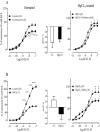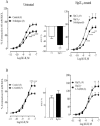The roles of potassium channels in contractile response to urotensin-II in mercury chloride induced endothelial dysfunction in rat aorta
- PMID: 30349568
- PMCID: PMC6184028
The roles of potassium channels in contractile response to urotensin-II in mercury chloride induced endothelial dysfunction in rat aorta
Abstract
Urotensin-II (U-II), the most potent vasoconstrictor that has recently been recognized as a new candidate in cardiovascular dysfunction, might exert vasoconstriction through, at least partially, potassium channels that are predominant in both endothelial and vascular smooth muscle cells (VSMCs). The present study was designed to evaluate the roles of potassium channels in vascular responses to U-II in intact and mercury induced endothelial dysfunction in rat aorta. The study involved pre-incubation of rat aortic rings with potassium channels blockers: charybdotoxin (chtx), tetraethylammonium (TEA), barium chloride (BaCl2), glibenclamide, 4-aminopyridine (4-AP) and clotrimazole. Then vascular responses to increased concentrations of human U-II (hU-II) were applied to each group in the presence and absence of mercury chloride (HgCl2). Urotensin-II efficacy was significantly increased in chtx, TEA and BaCl2 treated groups, while significantly decreased in glibenclamide and clotrimazole treated groups as compared with the control group. In the presence of mercury, hU-II efficacy was significantly changed in all groups except clotrimazole treated group. The novel findings were that potassium channels modulated the vascular contractile responses to hU-II in isolated rat aorta and mercury treatment increased hU-II efficacy and deteriorated potassium signaling.
Keywords: Endothelial dysfunction; Mercury; Potassium channels; Urotensin-II.
Figures






Similar articles
-
Endothelin-1 and angiotensin-II modulate urotensin-II vasoconstriction in rat aorta exposed to mercury.Bratisl Lek Listy. 2018;119(7):444-449. doi: 10.4149/BLL_2018_081. Bratisl Lek Listy. 2018. PMID: 30160135
-
Vascular contractile effect of urotensin II in young and aged rats: influence of aging and contribution of endothelial nitric oxide.Peptides. 2006 Jan;27(1):80-6. doi: 10.1016/j.peptides.2005.07.012. Epub 2005 Sep 12. Peptides. 2006. PMID: 16159683
-
A comparison of EDHF-mediated and anandamide-induced relaxations in the rat isolated mesenteric artery.Br J Pharmacol. 1997 Dec;122(8):1573-84. doi: 10.1038/sj.bjp.0701546. Br J Pharmacol. 1997. PMID: 9422801 Free PMC article.
-
The inhibitory effect of KT3-671, a nonpeptide angiotensin-receptor antagonist, on rabbit and rat isolate vascular smooth muscles: a possible involvement of K(ATP) channels.J Cardiovasc Pharmacol. 2000 Mar;35(3):457-67. doi: 10.1097/00005344-200003000-00017. J Cardiovasc Pharmacol. 2000. PMID: 10710133
-
Endothelial potassium channels, endothelium-dependent hyperpolarization and the regulation of vascular tone in health and disease.Clin Exp Pharmacol Physiol. 2004 Sep;31(9):641-9. doi: 10.1111/j.1440-1681.2004.04053.x. Clin Exp Pharmacol Physiol. 2004. PMID: 15479173 Review.
Cited by
-
The roles of melatonin and potassium channels in relaxation response to ang 1-7 in diabetic rat isolated aorta.Cytotechnology. 2025 Apr;77(2):55. doi: 10.1007/s10616-025-00720-y. Epub 2025 Feb 5. Cytotechnology. 2025. PMID: 39927136
References
-
- Al Kindi, H, Hafiane, A, You, Z, Albanese, I, Pilote, L, Genest, J, Schwertani, A. Circulating levels of the vasoactive peptide urotensin II in patients with acute coronary syndrome and stable coronary artery disease. Peptides. 2014;55:151–157. - PubMed
-
- Angeli, JK, Cruz Pereira, CA, De Oliveira Faria, T, Stefanon, I, Padilha, AS, Vassallo, DV. Cadmium exposure induces vascular injury due to endothelial oxidative stress: the role of local angiotensin II and COX-2. Free Radic. Biol. Med. 2013;65:838–848. - PubMed
-
- Behm, D, Mcatee, J, Dodson, J, Neeb, M, Fries, H, Evans, C, Hernandez, R, Hoffman, K, Harrison, S, Lai, J. Palosuran inhibits binding to primate UT receptors in cell membranes but demonstrates differential activity in intact cells and vascular tissues. Br. J. Pharmacol. 2008;155:374–386. - PMC - PubMed
LinkOut - more resources
Full Text Sources
